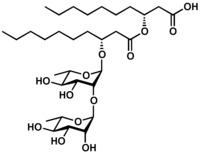
Effect of biosurfactant derived from Vibrio natriegens MK3 against Vibrio harveyi biofilm and virulence
Sign Up to like & getrecommendations! Published in 2019 at "Journal of Basic Microbiology"
DOI: 10.1002/jobm.201800706
Abstract: Vibrio harveyi is a marine luminous pathogen, which causes biofilm‐mediated infections, pressures the search for an innovative alternate approach to strive against vibriosis in aquaculture. This study anticipated to explore the effect of glycolipid biosurfactant… read more here.
Keywords: biosurfactant; vibrio; effect; harveyi ... See more keywords

New lipopeptide produced by Corynebacterium aquaticum from a low-cost substrate
Sign Up to like & getrecommendations! Published in 2018 at "Bioprocess and Biosystems Engineering"
DOI: 10.1007/s00449-018-1946-8
Abstract: Conventional biosurfactants have high production costs. Therefore, the use of low-cost carbon sources for their production is attractive for industry. The ability to remain stable under various environmental conditions further extends industrial application. Here we… read more here.
Keywords: biosurfactant; produced corynebacterium; new lipopeptide; low cost ... See more keywords

Production of the biosurfactant serrawettin W1 by Serratia marcescens S-1 improves hydrocarbon degradation
Sign Up to like & getrecommendations! Published in 2021 at "Bioprocess and Biosystems Engineering"
DOI: 10.1007/s00449-021-02625-4
Abstract: With the frequent occurrence of oil spills, the bioremediation of petroleum hydrocarbons pollution has attracted more and more attention. In this study, we investigated the biodegradation of crude oil by the biosurfactant-producing strain S-1. The… read more here.
Keywords: production biosurfactant; biosurfactant; degradation; serratia marcescens ... See more keywords

Efficiency of bacterial biosurfactant for biocontrol of Rhizoctonia solani (AG - 4) causing root rot in faba bean (Vicia faba) plants
Sign Up to like & getrecommendations! Published in 2018 at "European Journal of Plant Pathology"
DOI: 10.1007/s10658-018-01639-1
Abstract: Biosurfactants are a structurally diverse group of surface-active compounds produced by microorganisms, with numerous applications in different fields. In the present study, we evaluated the antifungal activity of a biosurfactant produced by Bacillus licheniformis against… read more here.
Keywords: biosurfactant; faba bean; root rot; rhizoctonia solani ... See more keywords

Biosurfactant produced by Bacillus subtilis V26: a potential biological control approach for sustainable agriculture development
Sign Up to like & getrecommendations! Published in 2020 at "Organic Agriculture"
DOI: 10.1007/s13165-020-00316-0
Abstract: Exploitation of microbial metabolites as biocontrol agents is considered an alternative to chemical pesticides in organic farming, due to their extensive potentiality in enhancing crop protection and food safety. The present work elucidates antifungal and… read more here.
Keywords: biosurfactant; agriculture; subtilis v26; biosurfactant produced ... See more keywords

First report of the production of a potent biosurfactant with α,β-trehalose by Fusarium fujikuroi under optimized conditions of submerged fermentation
Sign Up to like & getrecommendations! Published in 2018 at "Brazilian Journal of Microbiology"
DOI: 10.1016/j.bjm.2018.04.004
Abstract: Biosurfactants have many advantages over synthetic surfactants but have higher production costs. Identifying microorganisms with high production capacities for these molecules and optimizing their growth conditions can reduce cost. The present work aimed to isolate… read more here.
Keywords: biosurfactant; production; optimized conditions; fusarium fujikuroi ... See more keywords

Biosurfactant mediated bioelectrokinetic remediation of diesel contaminated environment.
Sign Up to like & getrecommendations! Published in 2020 at "Chemosphere"
DOI: 10.1016/j.chemosphere.2020.128377
Abstract: The present study integrated the electrokinetic (EK) with bioremediation (Bioelectrokinetic -BEK) of diesel hydrocarbon by Staphylococcus epidermidis EVR4. It was identified as efficient biosurfactant producing bacteria and growth parameters was optimized using response surface methodology.… read more here.
Keywords: biosurfactant; diesel contaminated; diesel; remediation diesel ... See more keywords

Investigation of the structural, physicochemical properties, and aggregation behavior of lipopeptide biosurfactant produced by Acinetobacter junii B6.
Sign Up to like & getrecommendations! Published in 2018 at "International journal of biological macromolecules"
DOI: 10.1016/j.ijbiomac.2018.01.209
Abstract: In the present study the produced biosurfactant of Acinetobacter junii B6 (recently isolated from Iranian oil excavation site) were partially purified and identified by high performance thin layer chromatography (HPTLC), Fourier transform infrared spectroscopy (FTIR),… read more here.
Keywords: biosurfactant; lipopeptide biosurfactant; acinetobacter junii; investigation structural ... See more keywords

Characterization of biosurfactant produced by the endophyte Burkholderia sp. WYAT7 and evaluation of its antibacterial and antibiofilm potentials.
Sign Up to like & getrecommendations! Published in 2020 at "Journal of biotechnology"
DOI: 10.1016/j.jbiotec.2020.03.005
Abstract: The endophyte Burkholderia sp. WYAT7 isolated from the medicinal plant Artemisia nilagirica (Clarke) Pamp. was analyzed for its ability to produce biosurfactant. The evaluation of biosurfactant production was conducted using different screening methods which confirmed… read more here.
Keywords: burkholderia wyat7; biosurfactant; biosurfactant produced; endophyte burkholderia ... See more keywords

Sustainable strategy for the enhancement of hazardous aromatic amine degradation using lipopeptide biosurfactant isolated from Brevibacterium casei.
Sign Up to like & getrecommendations! Published in 2020 at "Journal of hazardous materials"
DOI: 10.1016/j.jhazmat.2020.124943
Abstract: The application of biosurfactants for the degradation of various toxic compounds has received much attention among researchers worldwide. A stimulated degrading method was carried out in this research to determine the efficiency of surfactant on… read more here.
Keywords: strategy; biosurfactant; brevibacterium casei; aromatic amine ... See more keywords

Preservative and Irritant Capacity of Biosurfactants From Different Sources: A Comparative Study.
Sign Up to like & getrecommendations! Published in 2019 at "Journal of pharmaceutical sciences"
DOI: 10.1016/j.xphs.2019.02.010
Abstract: One of the most important challenges for pharmaceutical and cosmetic industries is solubilization and preservation of their active ingredients. Therefore, most of these formulations contain irritant chemical additives to improve their shelf-life and the solubility… read more here.
Keywords: biosurfactant; capacity biosurfactants; capacity; irritant capacity ... See more keywords